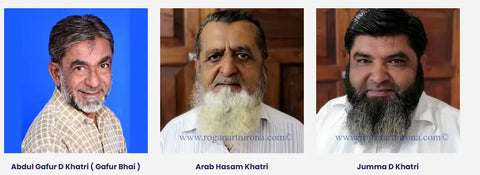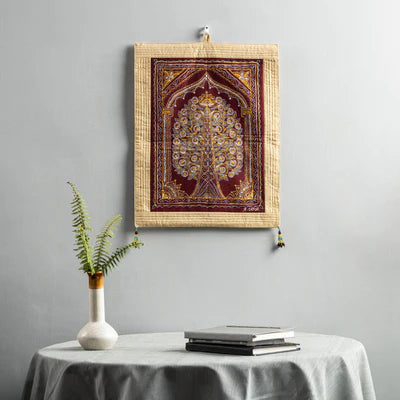Traditional Story!
Traditional Rogan art, a method of cloth painting, is a four-century-old art form exclusively practised in the Kutch district of Gujarat, India. Until recently, Rogan art was on the brink of extinction, but was revived by the efforts of Abdul Gafur khatri and his younger brother Sumar Daud Khatri family. Sahil is the youngest member of the current 8th generation.

Rogan painting is an inherited art form that has been around for 400 years. It is to have originated from Muslim Khatris and was practised exclusively in the Gujarat region. The Abdul Gafur Khatri family in north-western state of Gujarat has been trying to revive the art form since the 1980s by painting things other than ceremonial clothing, hosting exhibitions and spreading awareness about the art form. To be a Rogan artist, one had to be a male member of a lineage that practised the art.

Unfortunately, these traditional requirements of Rogan painting made the art especially prone to dying out. In the past, many families in Gujarat practised Rogan art. Nowadays there is only one Abdul Gafur khatri family left. They were traditionally making Skirts, Quilt covers, Big size bags, Table cloths, Odhani and Ghaghara- Choli used by women etc. from Rogan art. When machine-made industrial textiles prevailed over handmade rogan art in the 1980s, those who practised the art struggled to make ends meet and had to look for new jobs.Abdul Gafur Khatri and his younger brother Sumar Daud Khatri was one of them. It was a difficult beginning for both of them. "The Abdul Gafur Khatri and his younger brother Sumar Daud Khatri ji could not even jugaad two times' bread and In such a situation, I did not even get the opportunity to study 4 Gujarati, I had to leave school to do other work."The demand for rogan painted fabrics was little compared to more affordable industrial textiles. Abdul Gafur Khatri had lost hope in making a living with the art form that had been passed down in his family for centuries. He left his village Nirona in the early 1980s to find a job in Ahmedabad and then Mumbai. Nevertheless, his journey was cut short when he received a letter from home after two years. The Gujarat government had a project for the family and he was needed back home.
Upon his return, Abdul Gafur Khatri realized his importance in preserving the legacy of his ancestors. If he were to abandon the art, it would go extinct. With this sense of responsibility, he fought through poverty and promised to sustain the art. Today, he has been practising Rogan art for almost 50 years. The family actively participates in conferences, exhibitions and workshops to spread awareness about Rogan Art. visiting Abdul Gafur Khatri house, Nirona Village which is about 40 km from Bhuj, to see his work.
A true revival of the art occurred in 2014 when Indian Prime Minister Modi gifted former US President Obama and recently gifted to orange colour rogan art tree of life to denmark queen margrethea Rogan art piece made by Abdul Gafur Khatri and his younger brother Sumar Daud Khatri that depicted the tree of life. After that, tourists began pouring into Kutch to see the Khatri family work on their art.

“ Not just Khatri, even his brothers are acclaimed artists of Rogan art. “My entire family is engaged in this at present. All of us are award winners. We have Padma shri Award and International craft Awards and (4) National Award and three National Merit Certificates and (7) State Awards in my family. Although the methods and processes of rogan art are known by others today, the real know-how is hidden in the intricate details that only the Abdul Gafur Khatri family knows. The family has been continuing this four-century-old tradition for eight generations.”
This content was originally published on roganartnirona
Blogs you might also like:
Indian Dupattas Of The Late 1990s That Are Still Popular
Stunning “Phad” Art from Rajasthan
Sarasa—The Gujarati kalamkari cloth that became a rage in Japan
 Verified Purchase
Verified Purchase



































































































































































































Leave a comment (all fields required)